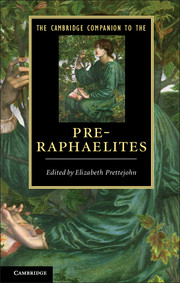Book contents
- Frontmatter
- Introduction
- PART ONE PRE-RAPHAELITISM
- PART TWO PRE-RAPHAELITES
- 6 The poetry of Dante Gabriel Rossetti (1828–1882)
- 7 The painting of Dante Gabriel Rossetti
- 8 William Holman Hunt (1827–1910)
- 9 John Everett Millais (1829–1896)
- 10 Ford Madox Brown (1821–1893)
- 11 Christina Rossetti (1830–1894)
- 12 Elizabeth Eleanor Siddall (1829–1862)
- 13 The writings of William Morris (1834–1896)
- 14 The designs of William Morris
- 15 Edward Burne-Jones (1833–1898)
- 16 Algernon Charles Swinburne (1837–1909)
- 17 William Michael Rossetti (1829–1919)
- 18 Envoi
- Appendix 1 The contents of The Germ
- Appendix 2 The Pre-Raphaelite ‘list of Immortals’
- Guide to further reading and looking
- Cambridge Companions to …
- Index
11 - Christina Rossetti (1830–1894)
from PART TWO - PRE-RAPHAELITES
Published online by Cambridge University Press: 28 September 2012
- Frontmatter
- Introduction
- PART ONE PRE-RAPHAELITISM
- PART TWO PRE-RAPHAELITES
- 6 The poetry of Dante Gabriel Rossetti (1828–1882)
- 7 The painting of Dante Gabriel Rossetti
- 8 William Holman Hunt (1827–1910)
- 9 John Everett Millais (1829–1896)
- 10 Ford Madox Brown (1821–1893)
- 11 Christina Rossetti (1830–1894)
- 12 Elizabeth Eleanor Siddall (1829–1862)
- 13 The writings of William Morris (1834–1896)
- 14 The designs of William Morris
- 15 Edward Burne-Jones (1833–1898)
- 16 Algernon Charles Swinburne (1837–1909)
- 17 William Michael Rossetti (1829–1919)
- 18 Envoi
- Appendix 1 The contents of The Germ
- Appendix 2 The Pre-Raphaelite ‘list of Immortals’
- Guide to further reading and looking
- Cambridge Companions to …
- Index
Summary
In 1847, when Christina Rossetti was sixteen, her grandfather Polidori published her first book of poetry, Verses: Dedicated to my Mother, on his private press. Her oldest brother, Dante Gabriel, drew illustrations for selected poems on special art paper; these were then inserted between appropriate leaves and bound into one of her personal copies. Themes of love and death, with Gothic moods, medieval settings, dream visions and Christian symbolism, pervade both poems and pictures. This small extra-illustrated volume bears witness to the siblings' shared ‘Pre-Raphaelite’ aesthetic before the formation of the Brotherhood the following year. Fundamentally collaborative in methodology and expression, this aesthetic brings into communion the visual and the verbal, the past and the present, the spiritual and the material, the reader/viewer and the maker. For the devout Christina this intensely symbolic, precisely realized methodology was especially directed towards reading ephemeral signs for the eternal truths they could disclose. She was, in every way, a woman of the book. If Pre-Raphaelite art schools its viewers in ‘close looking’, the Pre-Raphaelite poetry of Christina Rossetti seeks to instruct its readers in close reading and interpretation.
As this illustrated copy of Verses suggests, Christina Rossetti had a central, if understated, role in Pre-Raphaelitism as it emerged in 1848. Excluded by her gender from meetings of the Brotherhood, she was, nevertheless, far more than an interested bystander. An influential force and early practitioner of the visual-verbal aesthetic that distinguished the movement, Christina was involved in collaborative projects with many of its members. She modelled as the mother of God for Dante Gabriel Rossetti’s first two oil paintings, The Girlhood of Mary Virgin (1848–9, Figure 6 ) and Ecce Ancilla Domini! (1849–50, Tate). She also sat for William Holman Hunt’s The Light of the World (1851–3, Figure 5), as he wished to catch her expression in his representation of Christ’s face; in the collaborative spirit that characterized the movement Christina took up the same subject in her contemporary poem, ‘Behold, I stand at the door and knock’.
- Type
- Chapter
- Information
- The Cambridge Companion to the Pre-Raphaelites , pp. 164 - 182Publisher: Cambridge University PressPrint publication year: 2012
- 1
- Cited by



